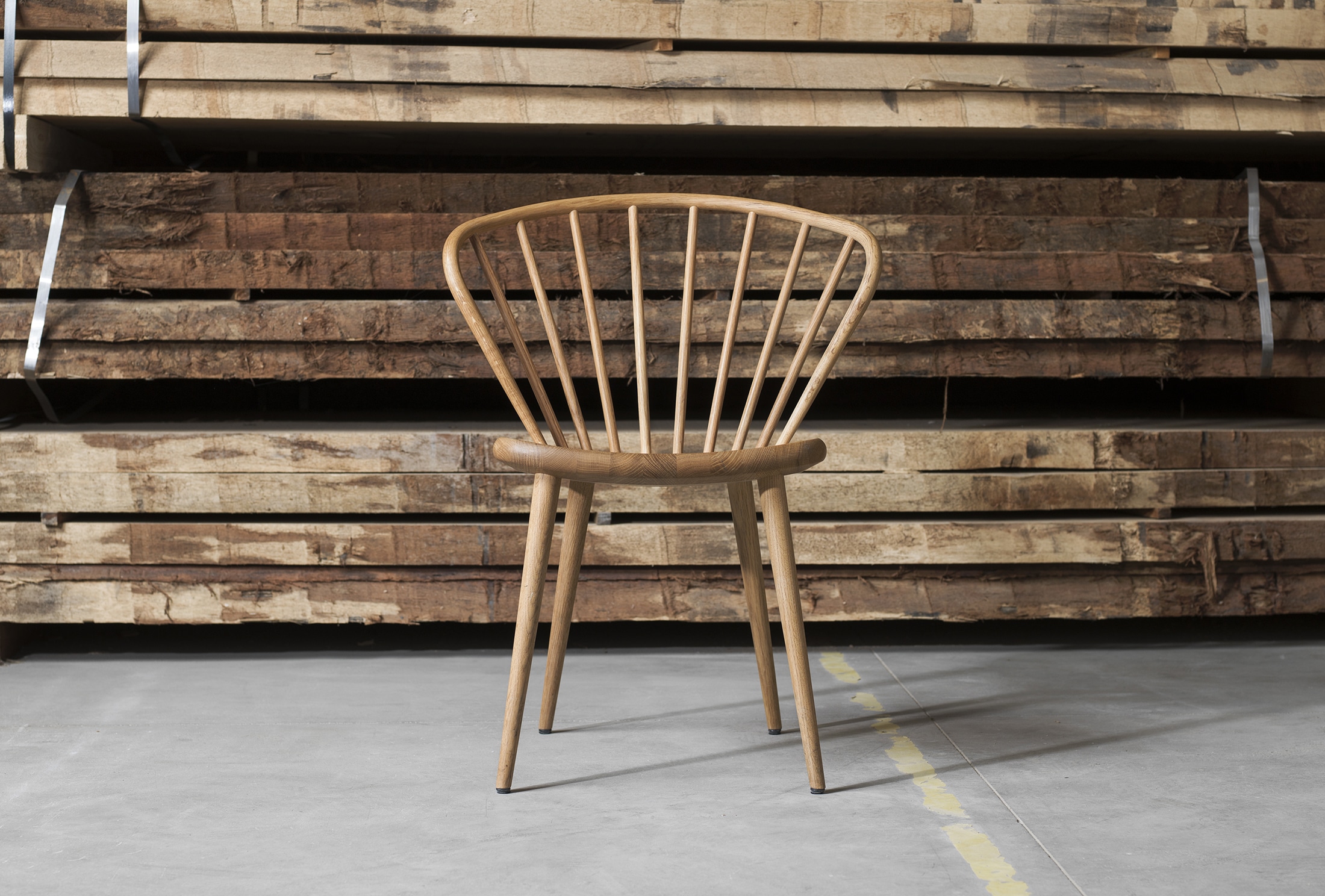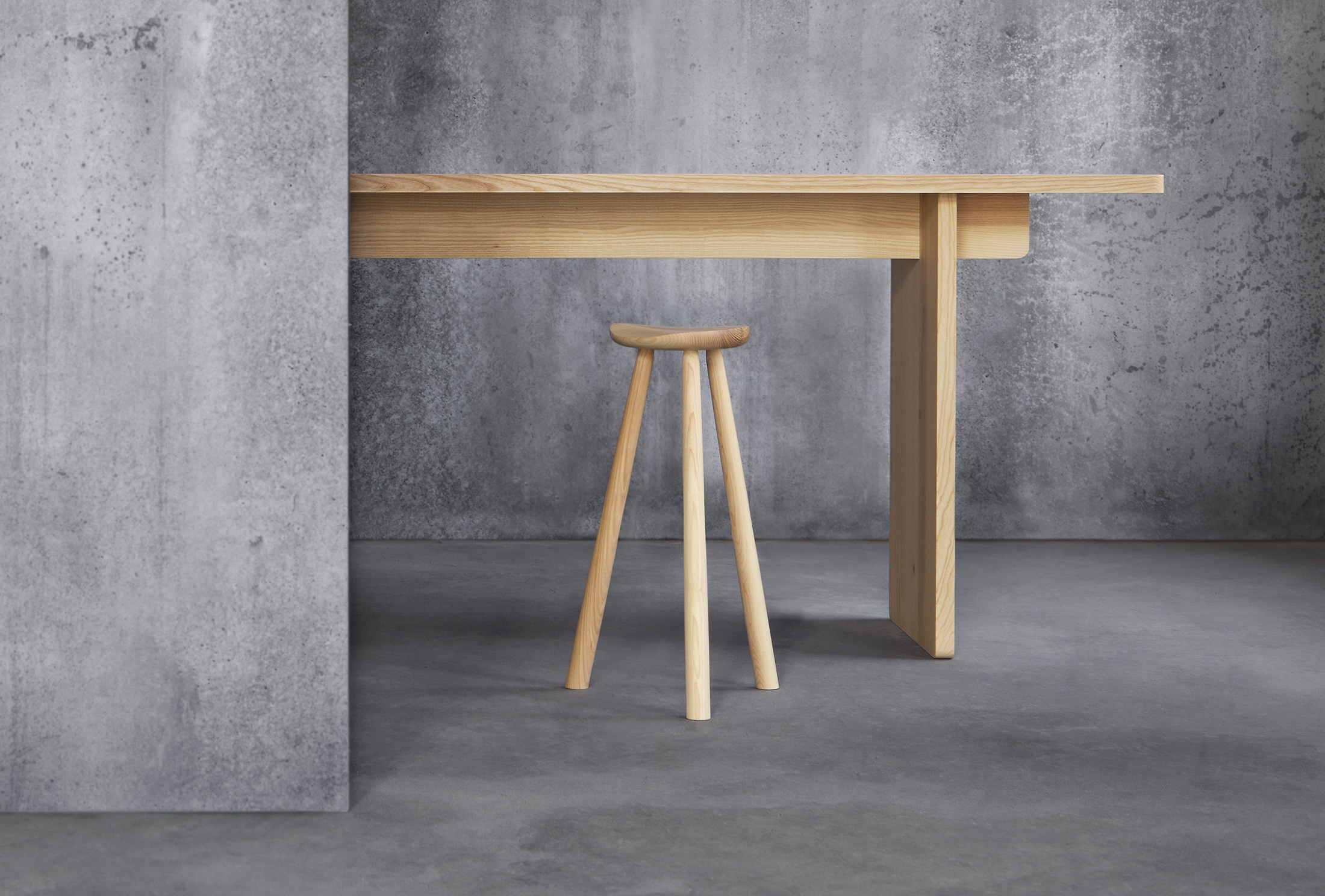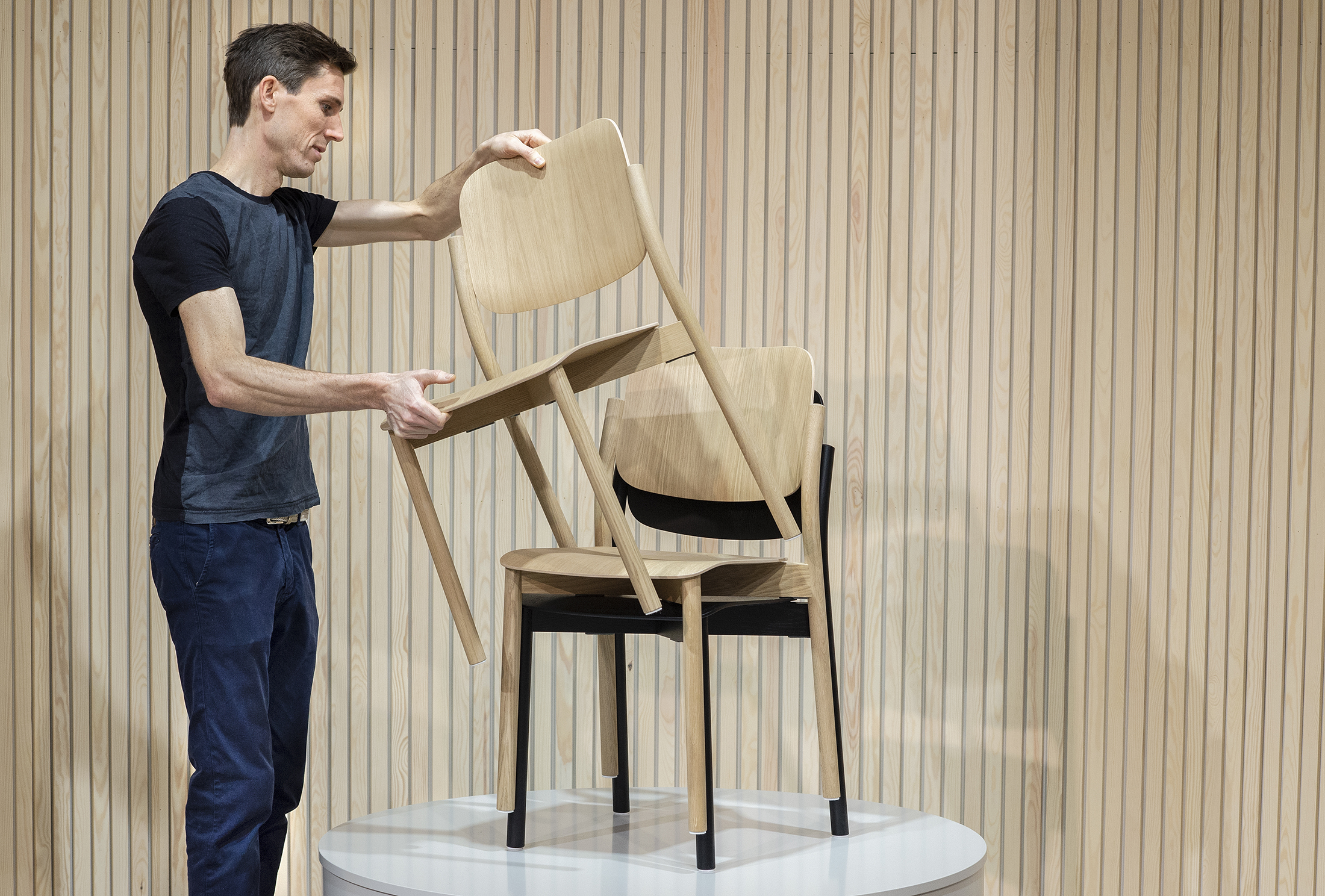Nature’s own super material
Wood is a material like no other. It lives and breathes, expands and contracts. Consequently, there’s a distinct art to producing furniture and fittings from wood, on the part of both producer and designer. We talked to Martin Johansson from Stolab, Johanna Vuorio from Nikari, and Jonas Forsman, a freelance designer, about the charms and challenges of working with nature’s very own super material.
The region around Smålandsstenar boasts a wealth of forest. This is dominated by spruce and pine, but beech, oak, ash and birch are also strongly represented. Beside the river Nissan, not far from the boundaries with both Halland and Västra Götaland, stands a factory emitting a pleasing scent that takes us back to our woodwork activities in school. It’s a factory where Stolab has been producing furniture for over one hundred years.
“Wood is something that has always been available close at hand for humans, especially for us here in the Nordic region. It’s not a raw material that’s refined in a laboratory; you can actually see it with your own eyes out in nature. I feel that this creates a special, natural connection to the material for us as humans.”
These thoughts come from Martin Johansson. He is CEO of Stolab, and perhaps has an even stronger bond with wood than he feels exists in general among people.
“When I handle wood, I get the sense of a material that is very tactile. Whereas metal can feel cold and plastic slightly artificial, wood has a warm, natural feel to it. The whole physical relationship with wood is really positive.”
From forest to chair
As mentioned, Stolab has been producing furniture at this same site for over one hundred years, and it was no coincidence that they ended up in this particular spot. Production of wooden furniture begins with forestry operations, and in the region around Smålandsstenar there’s no shortage of know-how, or of raw materials. Trees are generally felled in winter, as there’s less water content in the wood, which makes it simpler to dry the material and reduce its moisture ratio. And moisture is one of the biggest challenges when it comes to creating furniture.
“Wood behaves a little like skin, in that it swells when it absorbs water. With a table top that is 1 metre wide, its dimensions can differ by 1 cm between summer and winter. Or take our Lilla Åland chair as an example. If one of the turned spindles for the chair back is too moist when it is assembled, it will dry out once the chair is placed in dry indoor air. This will result in the wooden component ultimately becoming too small and suddenly no longer fitting properly.”
After felling, the timber is air-dried, and in many cases placed in a drying kiln to get the moisture ratio down to 7% – the standard for furniture production.
“It’s an essential and fairly risky process that requires a cool head. If you rush the drying process, this can result in discolouration and cracks.”
The next step is to saw the material up into smaller piece known as blanks. These blanks are then sawn, milled and worked, to ultimately be turned into component parts for a product. This is where a wood manufacturer’s biggest enemy of all begins lurking in the wings. An enemy that is something of a contrast to moisture, namely fire.
“That is what anyone working with wood is most afraid of. Piles of shavings or swirls of wood dust represent a major ignition risk. We have to work hard in the factory to keep our working environment clean and safe. Stolab has survived two world wars and a number of global financial crises, but fire is, and always has been, the biggest threat.”
Different woods, different characteristics
The kind of wood you choose to work with may often be determined by cultural factors, in the opinion of Martin, especially further back in time when many of today’s wooden furniture producers first set up their operations. If a factory was located close to a coniferous forest, then the shop-floor would produce furniture made from pine or spruce.
“Here at Stolab we come from a tradition of using birch. Our production has been Swedish from the start and many sawmills in our vicinity worked with birch, making it the natural choice at the time. Solid birch is ideally suited to finishing with various colours, and it’s a wood that has long been a favourite with many people, not least in public environments. It’s a tough, medium-hard timber that is elastic, and you can work with small dimensions and still have a durable material. It’s easy to dry and easy to glue, but has a tendency to warp at times when bending.”
As Stolab has expanded its range, other kinds of wood have been introduced into their operations. All with their own individual peculiarities.
“Oak, for example, is heavy, strong and hard with really good wearing qualities, but it is slow to dry and can require great care when gluing. The material selected is governed by the product to be manufactured. For a table top or something else that needs to be stable and resistant to wear and tear, oak can be the perfect choice. For a bentwood chair, however, ash may be a better option, as it bends more easily than either oak or birch.”
Timber from a single tree can also differ. Martin is in the habit of comparing timber raw material with beef cattle, and believes that even organic, natural-grazing cattle yield both fillet steak and cuts better suited for mincing. A metaphor that also lends itself to Stolab’s efforts involving re-use as a means of creating new production in a sustainable way:
“Naturally we only want to use the fillet steak. A casual onlooker might think “wood is just wood”, but there are huge differences. This approach resurfaces in our recycling. A restaurant doesn’t throw away a fillet steak that hasn’t been cooked, they make steak tartare or something else from it. In the same way we use waste material that is left over and make something new out of it.”

Nordic handicraft tradition
We leave Smålandsstenar temporarily and head just over 800 km north east, across the Baltic, to south-western Finland and the little village of Fiskars. Here, housed in the oldest machinery workshop in the country, we find Nikari, combining traditional wood craftsmanship with modern design.
Nikari was founded in 1967 as a one-man workshop run by one of Finland’s best-known cabinet makers of all time – Kari Virtanen. Schooled in traditional carpentry, he shaped the future of the company in close collaboration with his first two customers: architectural icon Alvar Aalto, and one of the leading figures within Finnish design history, Kaj Franck. The combination of traditional craftsmanship using solid wood and the latest in design and architecture immediately became part of the company’s philosophy. Nikari has since grown to become one of the Nordic region’s leading producers of wooden furniture and fittings, and at the same time an instructor in and protector of Nordic woodworking traditions.
“In addition to craftsmanship and modern design, our philosophy has always been deeply rooted in sustainability and education – manufacturing products with minimal environmental impact and keeping handicraft knowledge alive in the modern world,” explains Johanna Vuorio, CEO of Nikari.
Outside collaboration
Jasper Morrison, Louise Campbell, Alfredo Häberli and Harri Koskinen. These are just a few of the names from Nikari’s impressive list of design partnerships. Many of the company’s products have been designed by external designers, a significant number of them with no previous knowledge of wood as a material. This is something that can be a major challenge for both producer and designer, yet also something that can yield exceptional results, in the opinion of Johanna:
“Wood is a living material, and the designer must respect its properties, strengths and weaknesses. The laws of physics have to be taken into account in order to create a functional product. Once a talented and dedicated designer understands this, the end result can be truly inspiring, perhaps even a classic. We appreciate skilled professionals who can understand the material and design products that will stand the
test of time, both technically and aesthetically.”
Timeless over trendy
As is well known, the aesthetic element of interior design is an area where trends and fashions can shift rapidly from year to year. The classic look frequently manifested by wooden furniture is often described as timeless, and Nikari don’t give too much thought to matching their designs to a specific trend, although naturally they should have a modern feel.
“It’s more about the fact that we are curious and interested in improving the collections we have. By collaborating with a variety of talented designers, with the aim of creating something that is slightly better than what we have seen previously, we hope to create products that are timeless. Products that fit well in various settings dating from different periods, and that can be used for centuries to come,” says Johanna, and continues:
“We have also noted that the handicraft tradition in our region tends to add something extra to the products. It could be the radius of curvature of a corner or the assembly of the base on a table. Small details that reflect the Nordic heritage in our craftsmanship.”
A popular material
Perhaps it’s this Nordic handicraft heritage, together with the proximity to forests, as mentioned by Martin Johansson, that has made wooden products so popular and appreciated in Scandinavia? Johanna feels that the popularity of wood is steadily increasing. And in recent years this popularity has also spread to latitudes further from the Arctic Circle, and often goes hand in hand with increased interest in sustainability.
“There seems to be growing interest in natural materials and in the common sense of using these throughout the world. We are pleased to see that more and more people are going in for more sustainable construction in close collaboration with architects in order to create natural, healthy and comfortable environments in offices, schools, hotels, restaurants,… well, everywhere really! Perhaps the time of fast, synthetic interiors that wear out and are discarded on an annual basis is gradually coming to an end, with the focus shifting instead to recycling and only refurbishing when necessary.”

A designer’s point of view
So far our journey has given us a perspective on manufacturing and how producers view the material, but what’s it like as a designer working with wood? To answer this, we head back to Sweden, and Gothenburg more specifically, which is home to Jonas Forsman’s design studio, where he develops products that combine form and function and puts his woodworking skills to good use.
A quick glance at Jonas’ portfolio reveals impressive versatility. Everything from sofas and chairs to fire extinguishers and baby monitors have come from this studio. The list of collaborations is extensive and includes Moooi, Housegard and Innermost; likewise the list of awards, which includes a number of Red Dot Awards. Right now he is focusing on the Evo lounge chair and the Zoe chair, both using wood as their principal material.
“I actually started out in the field of wood, you could say. As a youngster, wood is often the first material you get to work with. I whittled heaps of butter knives in my younger days,” laughs Jonas, and continues:
“There was also a lot of carpentry involved in my studies at Stenebyskolan. You need to work a lot with wood to get a good sense of how the material behaves. It has a will of its own, and you have to ‘make friends’ with it, and in a way be guided by it.”
The design process
For Jonas, who also has a background within industrial design, the process often involves working “from the inside out”, with exciting forms derived from a smart function. This strategy involves employing materials suited to the purpose.
“This has steered me in the direction of wood on numerous occasions, as it’s a flexible material offering various advantages. Apart from the pure aesthetic aspects, wood provides greater scope for actually running tests and producing prototypes than other materials. A wooden product also develops its own soul over the years, with any marks becoming memories. That’s a major reason why I end up wanting to work more and more with wood. The products last a long time and take on a more authentic feel as time goes on.”
The versatility of Jonas’ work has resulted in experience with many different types of material. Although the basic strategy of the design process is similar whether it involves wood, plastic, metal or something else, certain elements of his approach differ when wood comes into the picture.
“With wood it’s slightly easier to draw inspiration from traditional, classic furniture. I know that the product will last and still look great 30 years down the line, so I often try to focus on a more timeless design. With wood I also tend to be more detail-oriented and take great care with every little detail.”
However, with a material that is not only living but also has a will of its own, challenges arise along the way.
“You can’t make everything precise with wood. Overly thin components and highly curved small parts are not possible, so you then have to combine it with other materials. You can’t achieve a really good cushioned feel either with wood. There’s a certain amount of give to wood, but if you want something softer you have to incorporate textiles.”
The more materials, the greater the challenges
These challenges were very much present when designing the Evo lounge chair, which was showcased at a number of fairs in the spring. The chair has been designed with a solid wooden base, with a knitted textile cover stretched over the seat for increased comfort. Small metal wires were required to secure the textile cover, as it was not possible to manufacture these components from wood.
“Our starting point was sustainability, so wood seemed a natural choice. I wanted the chair to be perceived as wooden furniture that offers a comfortable feel without padded material. The challenge was in finding natural ways to combine the materials. How do I stretch the textile? How do I keep it taut over time? How do I create attractive interactions between metal, textile and wood?”
Using a variety of materials also means a complex collaboration between different suppliers and factories, and it can also make recycling more difficult. This is something that Jonas is meticulous about:
“I want to try to minimise the number of materials, and at the same time isolate them. It’s essential for the wooden base to be separate, the metal to be separate and so on, so that the overall product can be separated into individual materials for recycling.”

A bright future
When Jonas, Johanna and Martin are asked to look ahead by way of conclusion, they are in agreement: the future of wood as an interior design material looks bright. All three have noticed a positive trend and feel that wood is a perfect fit for the times.
From a manufacturer’s perspective, Martin thinks that the biggest challenge is securing raw material supplies so that good-quality wood continues to be obtainable. Huge demand for building and construction timber in Sweden and the rest of Europe has resulted in a declining number of sawmills focusing on hardwood:
“This could be due to the fact that there are so few of us hardwood furniture producers in Sweden today. But actual views on wood among consumers are becoming increasingly positive. This particular development is clear from the fact that we are painting our products less and less, and instead varnishing or oiling them. It seems that people want to experience that closeness to trees again,” says Martin.
Johanna has also noted the positive trend, and when she looks ahead, sustainability and environmental considerations are central elements of the vision for the future. A vision where a natural material like wood assumes a
prominent role, naturally enough:
“I hope that we will get to see shrewd long-term solutions in the construction and interior design sectors, involving smart use and recycling of natural materials. Wood, with its natural ability to absorb carbon dioxide from the atmosphere, is perfect for use in buildings and furniture that can be utilised for centuries to come. Healthy environments, natural materials and architecture on a human scale are interesting prospects for the future,” she concludes.
The environment is also the focus for Jonas and he agrees with his industry colleagues that the future for wood as an interior design material is looking bright, especially if we are aiming for a sustainable society:
“Wood has been increasing in popularity for many years now and I don’t really see that dropping off. With society becoming more and more careful about the environment and the climate, wood is a natural choice. Just think, such a strong and workable material that at the same time absorbs carbon dioxide – the greatest threat to our environment. If you were to discover such a material today, you would scarcely believe it was true!”



















